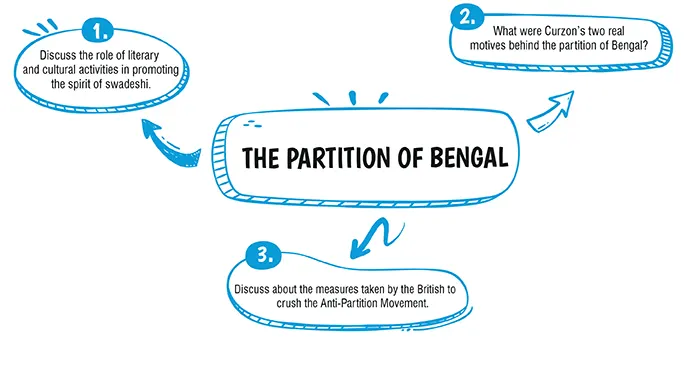Home / Board / ICSE / important Questions / Class 10 / History & Civics / The Partition of Bengal Important Questions
Table of Contents

Ans. (a) Dadabhai Naoroji
Explanation:
Dadabhai Nowrojee was the President of the 1906 session. For the first time, he pronounced the word Swaraj from the stage. In the same session Swaraj, Swadeshi, National Education, and Boycott, this 4 point program was unanimously accepted by the Indian National Congress.
Ans. (d) 1905
Explanation:
Lord Curzon served as the Viceroy of India from 1899 to 1905, and the partition of the Bengal province was implemented on October 16, 1905, during his tenure.
Explanation:
The swadeshi spirit witnessed the rise of literary activities that fostered nationalism. Songs, poems, popular dramas, novels and short stories written by eminent writers like Rabindranath Tagore, Ravi Kant, Aurobindo Ghose and Mukund Das propagated the spirit of swadeshi and nationalism. The journals and newspapers like Kesari, the Mahratta and Bande Mataram and Yugantar fostered a new spirit of nationalism in India. The folk theatres like Yatras in Bengal gave a great publicity to the swadeshi campaign.
Explanation:
Curzon’s motives behind the partition of Bengal were :
(i) To curb the radical Bengali nationalists and thus, to weaken the nationalist movement.
(ii) To set the Hindus and Muslims against each other.
Explanation:
The government followed a policy of repression to stop the Swadeshi and Boycott Movement, which was launched as a reaction against the partition of Bengal in 1905.
(i) The people and local leaders were beaten mercilessly by the soldiers and hundreds were put behind the bars.
(ii) Meetings were disrupted and the political leaders were jailed. Lala Lajpat Rai and Ajit Singh were arrested and deported to Burma. In 1906, Tilak was sentenced to six years imprisonment.
(iii) The students were beaten, flogged and expelled. Teachers and professors were threatened with disciplinary action.
(iv) The British Government followed a policy of divide and rule. They tried to prevent Muslims from joining the Congress by following a policy of conciliation towards Muslims.
(v) Schools and colleges were warned. The Government grants to educational institutions which were suspected of participating in the Swadeshi Movement, were discontinued.
Download Mind Map of this chapter
Download NowWant to Practice Mock Tests of this chapter
Practice NowDownload Important Questions of this chapter
Download NowCBSE Important Questions Class 10
ICSE Important Questions Class 10
CBSE Important Questions Class 10
ICSE Important Questions Class 10